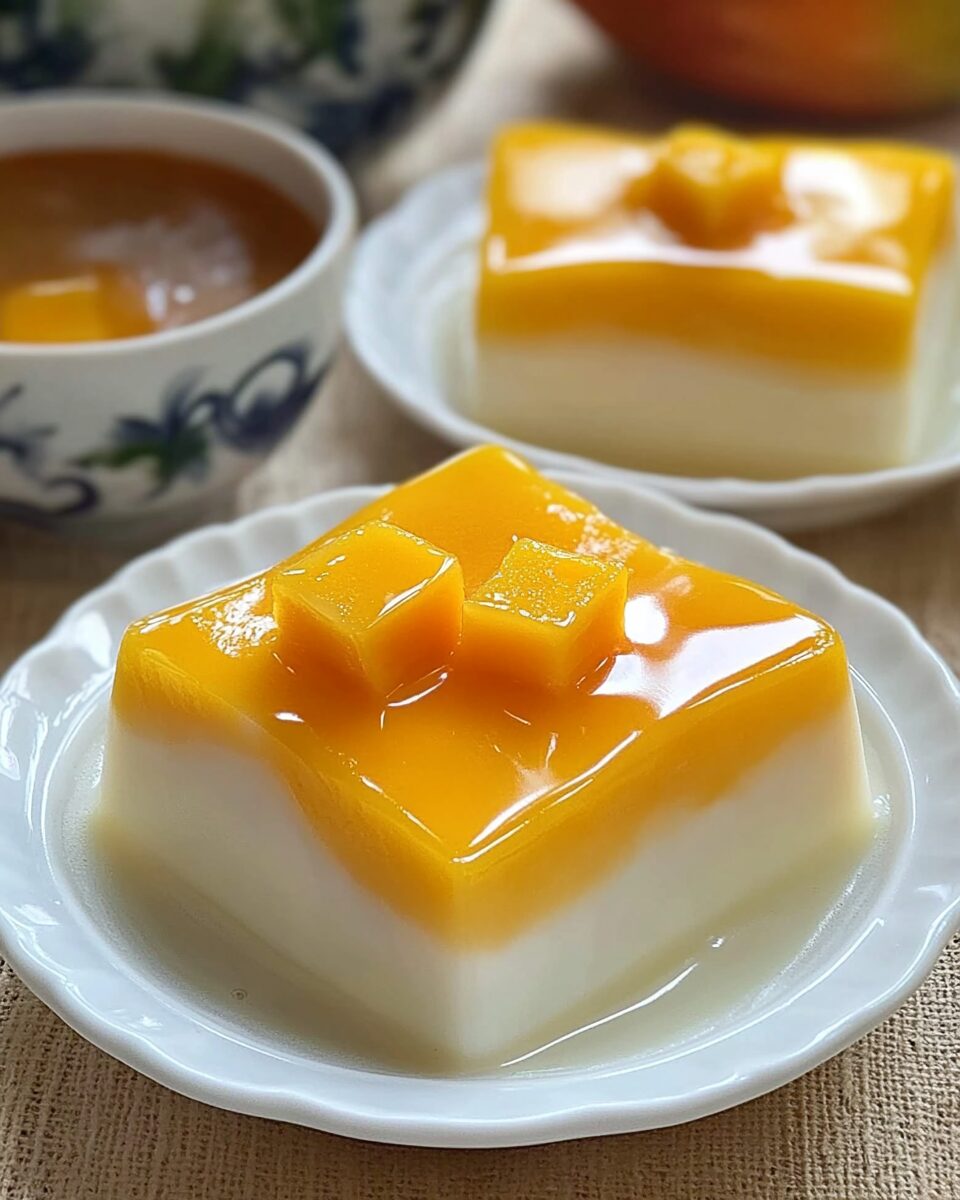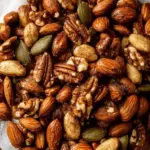This Chinese Mango Pudding is a refreshing, light dessert made with ripe mangoes, coconut milk, and a hint of condensed milk. It’s a classic Cantonese treat often served in Chinese restaurants and dim sum halls. Creamy, fruity, and delicately sweet, it’s the perfect chilled dessert for summer—or anytime you crave something tropical and not too heavy.
Full Recipe:
Ingredients
-
2 yellow and ripe mangoes (makes 1 cup mango purée)
-
¾ cup boiling water
-
2½ tsp gelatin (1 packet Knoxx gelatin)
-
½ cup coconut milk or half & half
-
1 tbsp condensed milk
-
½–1 tbsp sugar (adjust to mango sweetness)
Directions
-
Bloom Gelatin: Pour boiling water over the gelatin and mix well until fully dissolved. Set aside.
-
Make Mango Purée: Cut mangoes, blend until smooth. Use ripe or yellow mangoes for best flavor.
-
Combine Ingredients: In a pot, combine coconut milk, condensed milk, sugar, and the gelatin mixture. Add the mango purée and any optional mango chunks. Heat over low-medium until it gently simmers, stirring frequently (about 3–5 minutes). Do not boil.
-
Adjust Sweetness: Taste the mixture and adjust sugar or honey if needed, depending on the mangoes’ sweetness.
-
Set: Pour into small bowls or ramekins. Refrigerate overnight until fully set.
-
Serve: Top with extra mango chunks and a drizzle of diluted condensed milk (½ tsp water + 1 tsp condensed milk) for a creamy finish.
Nutrients (per serving, yields 4 servings)
-
Calories: 148 kcal
-
Carbohydrates: 21g
-
Protein: 4g
-
Fat: 7g
-
Saturated Fat: 6g
-
Cholesterol: 2mg
-
Sodium: 18mg
-
Potassium: 255mg
-
Fiber: 2g
-
Sugar: 18g
-
Vitamin A: 1133 IU
-
Vitamin C: 38mg
-
Calcium: 33mg
-
Iron: 1mg
A Cantonese Favorite with Global Appeal
Originating from Hong Kong and often served in Chinese dim sum halls, mango pudding has gained international popularity thanks to its delightful flavor and smooth texture. Unlike Western puddings that rely heavily on eggs or cornstarch, this version uses gelatin to achieve a firm yet tender consistency that melts delicately on the tongue.
The traditional preparation often includes evaporated milk or cream, but modern takes incorporate coconut milk or half-and-half, creating a dairy-optional twist that appeals to a broader range of dietary preferences. Its vibrant yellow color and naturally sweet flavor also make it a visually appealing dish that feels indulgent without being overly rich.
Mangoes: The Star of the Show
The key to an exceptional mango pudding lies in the fruit. Ripe, yellow mangoes—such as Ataulfo or Champagne varieties—are ideal for their rich sweetness, low fiber content, and naturally buttery texture. Their flavor is floral, slightly tangy, and perfectly suited to desserts. The fresher the mango, the better the result.
In this pudding, mangoes are puréed to create a smooth base, with optional chunks added for textural contrast. Their natural sugars contribute most of the dessert’s sweetness, allowing you to adjust the added sugar based on the ripeness of the fruit. If you’re making this when mangoes aren’t in season, high-quality frozen mango chunks or canned mango pulp (like Kesar or Alphonso) can be substituted, though fresh is always best for peak flavor.
Creamy Elements: Coconut Milk and Condensed Milk
Coconut milk adds a luxurious creaminess and subtle tropical flavor that complements the mango beautifully. Full-fat coconut milk is recommended for the best texture, as light versions may result in a thinner, less rich pudding. For those who prefer a more neutral taste, half-and-half or evaporated milk can be used instead of coconut milk.
A spoonful of condensed milk adds a creamy sweetness and depth, helping to bridge the fruitiness of the mango with the richness of the milk. This small addition balances the dessert without overpowering the natural mango flavor. For a dairy-free option, you can use coconut condensed milk or sweeten the pudding with honey or maple syrup.
Using Gelatin for a Delicate, Silky Set
Unlike custards or Western-style puddings thickened with cornstarch or eggs, Chinese mango pudding relies on gelatin for its unique texture. The gelatin is bloomed in boiling water to dissolve and activate its setting power before being incorporated into the pudding mixture. This technique ensures a uniform consistency throughout the dessert, creating a clean, sliceable texture that still feels soft and smooth on the tongue.
The gelatin quantity can be adjusted slightly for a firmer or softer set, depending on your personal preference. For a vegetarian version, agar-agar powder can be used in place of gelatin, though the setting process and texture may differ slightly.
Simplicity in Preparation, Elegance in Presentation
One of the biggest appeals of mango pudding is how easy it is to prepare. From start to finish, the process takes under 15 minutes, with the majority of the time spent chilling in the refrigerator. The ingredients are minimal, and the steps are straightforward—making it accessible for beginner cooks and perfect for preparing ahead of time.
Despite its simplicity, mango pudding presents beautifully. Once set in ramekins or dessert cups, the puddings can be turned out onto plates or served directly in their molds. Garnish with fresh mango chunks, a drizzle of diluted condensed milk, a sprig of mint, or even a light dusting of toasted coconut for added flair.
This makes it an ideal dessert for dinner parties or festive occasions. It’s light enough to follow a large meal, elegant enough to serve to guests, and beloved by both adults and children.
Nutrition Highlights: Light Yet Satisfying
While mango pudding tastes indulgent, it’s surprisingly light in calories and fat compared to many other desserts. Each serving provides around 150 calories and includes a balance of carbohydrates, fiber, and protein. Mangoes are high in vitamin C, vitamin A, and antioxidants, while coconut milk offers beneficial fats.
The use of gelatin adds a small amount of protein and supports digestive health, making this dessert a smart option when you want to end a meal on a sweet note without feeling overly full.
For those watching their sugar intake, the added sugar can easily be reduced or omitted depending on the sweetness of the mangoes. Swapping in a natural sweetener like stevia or monk fruit sweetener can make this recipe even more diabetic-friendly.
A Dessert for Every Season
Though often considered a summertime treat, Chinese mango pudding can be enjoyed year-round. It’s especially refreshing during the warmer months when mangoes are at their peak, but with the availability of high-quality frozen mango, it can be prepared even in the depths of winter when a burst of tropical sunshine is most welcome.
Its versatility and subtle elegance make it suitable for a wide range of occasions—from casual family dinners to Lunar New Year feasts or Mother’s Day brunches. It can be molded in individual cups, silicone molds, or even larger baking dishes to slice and serve family-style.
Tips for Success
-
Choose ripe, sweet mangoes. The flavor of the mango is the centerpiece, so quality counts.
-
Blend the purée until completely smooth for a luxurious texture, or leave a few chunks for contrast.
-
Don’t boil the mixture. Heating the base gently ensures the coconut milk doesn’t separate and the gelatin sets properly.
-
Chill thoroughly. Allow at least four hours, or overnight, for the pudding to set fully.
-
Customize your garnish. Mango chunks, mint, coconut flakes, or even edible flowers elevate the presentation.
Conclusion
Chinese Mango Pudding is a dessert that embodies simplicity, elegance, and freshness. Its rich mango flavor, creamy texture, and just-right sweetness make it a crowd-pleaser for all ages and occasions. Whether you’re serving it at a festive gathering, bringing a cool treat to a summer potluck, or simply treating yourself after dinner, this pudding offers tropical delight in every spoonful.
Rooted in tradition yet endlessly customizable, it’s a dessert that invites creativity and delivers satisfaction with minimal effort. Once you’ve tasted its cool, creamy goodness, you’ll see why this Cantonese classic has stood the test of time—and why it deserves a spot in your recipe repertoire.






